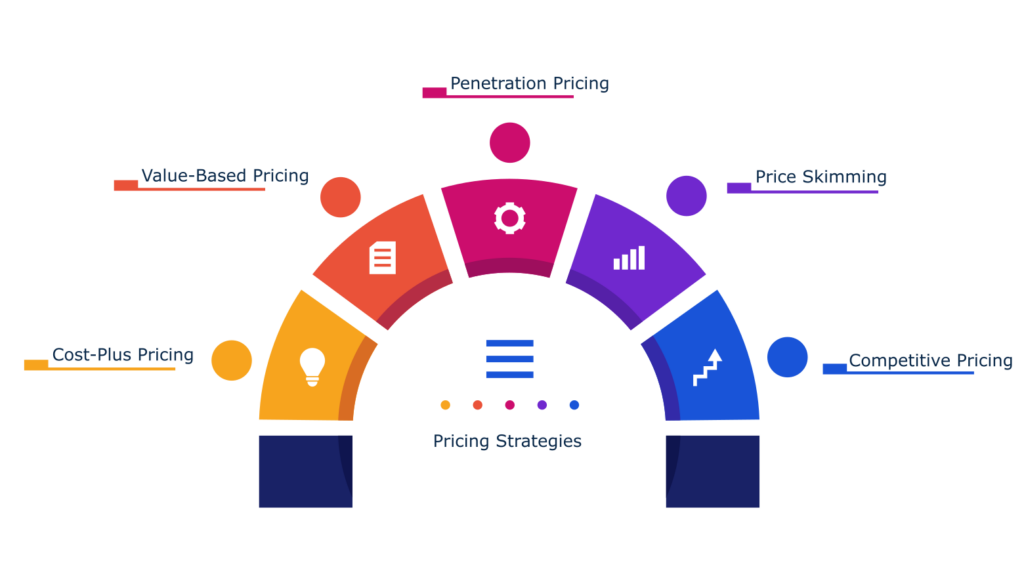
What Is A Pricing Strategy?
Pricing strategies helps businesses decide how much to charge for their products or services to make enough money and attract customers. To do this, they pay attention to things like how much it costs to make the product or provide the service, what their rivals are charging, who the customers are, and how they behave. There are a few pricing strategies to pick from, like making sure the price covers the cost of making the product plus some extra (cost-plus pricing), asking for more money because the product is worth it (value-based pricing), or starting off with a high price and lowering it over time (skimming pricing). It’s important to choose the best strategy for the company’s goals and what’s happening in the market. By doing this, the business can make more money, stand out from the competition, and keep its customers happy.
Why Are Pricing Strategies Important?
Having a good pricing strategy is essential for any business as it can determine its success or failure. A pricing strategy enables a business to reach its revenue goals, remain competitive, and maximize profits. Implementing a pricing strategy can also help businesses to attract and retain customers, improve market positioning, and understand the value of their products or services.
A good pricing strategy can help businesses to respond to market changes, customer demands, and adjust the prices according to the changing circumstances. Effective pricing strategies consider a wide range of factors, including competition, market demand, production costs, customer demographics, and profitability goals.
Ultimately, a good pricing strategy can boost a company’s overall performance and long-term sustainability by ensuring that prices remain appropriate, competitive and profitable. By understanding the importance of a pricing strategy, businesses can implement pricing plans that help achieve their financial objectives while meeting customer expectations.
What Factors Influence Pricing Strategies?
There are numerous factors that can influence a business’s pricing strategy, such as target market, competition, product uniqueness, cost of production, marketing and advertising budget, economic conditions, and pricing objectives.
These factors should be carefully considered before determining the product or service price point. Certainly, a key aspect to take into account is the level of demand for the product or service offered. A higher demand usually means a willingness on the part of customers to pay a higher price. Another essential factor that affects pricing strategy is competition. Companies try to offer prices that are lower than their competitors, while still ensuring they maintain enough profit margin. Production costs are also crucial, as they can significantly impact the final price. Additionally, a company’s objectives and market positioning are critical to determining the most effective pricing strategy. It is also important to recognize that customer demographics relating to income, preferences and willingness to pay can also play a role in setting prices that satisfy the needs of both the company and its customers.
What Are The Five Most Common Pricing Strategies?

Cost-Plus Pricing
Cost-plus pricing is a pricing strategy used by businesses where the selling price of a product or service is determined by adding a markup to the cost of production. A markup is an additional amount of money added to the cost price to determine the selling price. The markup includes the desired profit margin, which is the amount that will cover overhead costs and generate profit.
Cost-plus pricing is commonly used because it is simple to calculate and ensures that all costs associated with a product or service are covered, which means the business can earn a profit. However, this pricing strategy does not take into account the demand for the product or service, nor does it consider the prices that competitors charge. Therefore, businesses must also consider market factors and competition when setting prices.
Penetration Pricing
Penetration pricing is a pricing strategy used by businesses to attract customers by setting a lower price than the market price for their products or services. The goal of penetration pricing is to gain market share quickly by encouraging customers to try the product and subsequently gain loyalty. This pricing strategy is particularly useful when introducing a new product or service to a competitive market, or when a business needs to increase its market share rapidly. However, as the business gains market share, the pricing strategy may be adjusted to increase profit margins. It is important to note that while penetration pricing may initially result in lower profits, the long-term benefits of increased market share can be significant.
Value-Based Pricing
Value-based pricing is a pricing strategy that involves setting prices based on the value that a product or service provides to the customer. Instead of pricing a product based on its production costs or competitor pricing, a company will determine what customers are willing to pay based on the perceived value of the product or service. By understanding how much value a product provides to a customer, a company can set a higher price that is justified by the customer’s willingness to pay. This approach is based on the idea that customers will pay more for products or services that they perceive as highly valuable and beneficial to them. Value-based pricing can lead to increased revenue and profits for the company, while also providing a better customer experience by providing them with a product that meets or exceeds their expectations.
Price Skimming
Price skimming is a pricing strategy where a company sets a high price for its product or service when it is first introduced to the market. The goal of price skimming is to maximize profits by targeting early adopters or those willing to pay a premium for new products. This strategy allows the company to recoup its initial investment quickly and establish a premium brand image. As demand for the product decreases, the company gradually lowers the price to attract wider market segments. Eventually, the price will reach a point where sales volume is maximized, and the company can consider introducing new products or services at a higher price point once again. Price skimming is commonly used in technology and premium consumer goods markets.
Competitive Pricing
Competitive pricing is a strategy used by businesses to set prices for their products or services in a way that can compete effectively with similar offerings in the market. This involves analyzing the pricing strategies of competitors and setting prices that are either higher or lower depending on the value proposition and level of differentiation being offered. The aim of competitive pricing is to maintain market share, attract new customers and generate profit margins that are sustainable in the long term. However, businesses need to be aware that setting their prices too low can erode profit margins, while setting prices too high can lead to loss of market share. Therefore, it is important to strike a balance between being competitive in the market and ensuring a reasonable profit margin for the business.
Top Tips For Helping You Pick Your Pricing Strategy
There are several important factors to consider when choosing a pricing strategy for your business-
- Consider your market and industry standards to ensure that your pricing is competitive.
- Take into account your costs and desired profit margins.
- It is important to understand your target customer’s willingness to pay and what they perceive as the value of your offering.
- Consider the stage of your business. A new business may choose a lower price to gain market share, while an established brand may be able to charge premium prices.
- Take into account if your pricing strategy will be simple or more complex, and whether you will offer discounts or promotions.
Ultimately, it is important to regularly review and adjust your pricing strategy based on changes in your market, costs, and customer demand. Experimentation and research are key to finding the right pricing strategy for your business.
How Price Intelligence Helps With Your Pricing Strategies
Price intelligence software helps businesses track and analyze their competitors’ pricing strategies and overall market trends. This information can be used to optimize pricing strategies, increase sales and revenue, and improve profit margins. By providing real-time data on market pricing trends, businesses can ensure they are offering the best possible price to customers while still maintaining profitability.
The software can also help businesses identify potential gaps in their pricing strategy and take corrective action quickly. This can include price adjustments, promotional offers, and other targeted pricing strategies based on real-time market data.
Overall, price intelligence software helps businesses make informed and strategic pricing decisions that can help drive growth and profitability. It allows businesses to stay competitive in their markets, improve their customer offering, and optimize pricing for maximum revenue and profit.
Are You Interested In Price Intelligence?
If you would like a more in depth understanding of price intelligence and the benefits this brings to your business.


